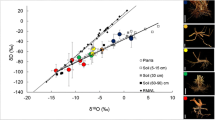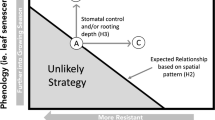Summary
Relatively static factors such as depth of rooting and cuticular conductance and relatively dynamic factors such as stomatol control and changes in the components of water potential were used to assess the drought resistance characteristics of six deciduous shrub species. Predawn water potential during a prolonged drought averaged-2.13 and-3.51 MPa in species known to have deep and shallow patterns of rooting, respectively. It is thus surprising that the osmotic potential at the turgor loss point averaged only-3.01 MPa in the shallow rooted group. The water potential at which irreversible cell damage occurred was the same in both groups (-4.9 MPa), and minimum values observed in the field never dropped below-4.0 MPa. There was, however, a pronounced difference between the two groups with regard to stomatal behavior. This allowed us to characterize the deep-rooted species as avoiders of stress which would cause prolonged stomatal closure whereas the shallow-rooted species had to tolerate prolonged periods of closed stomata.
Similar content being viewed by others
References
Duhme F (1974) Die Kennzeichnung der ökologischen Konstitution von Gehölzen im Hinblick auf den Wasserhaushalt. Dissertationes Botanicae 28. J. Cramer, Lehre p 143
Ehrendorfer F, Kaltenbach A, Niklfeld H, Starmühlner F (1972) Naturgeschichte Wiens. Vol. II: Naturnahe Landschaften, Pflanzen- und Tierwelt. Jugend und Volk, Wien München p 909
Eliás P (1978) Water deficit of plants in an oak-hornbeam forest. Preslia 50:173–188
Hempel G, Wilhelm K (1893) Die Bäume und Sträucher des Waldes in botanischer und forstwirtschaftlicher Beziehung. Verlag Ed. Hölzel Wien und Olmütz
Hinckley TM, Lassoie JP, Running SW (1978) Temporal and spatial variations in the water status of forest trees. Forest Sci Monogr 20:1–72
Hinckley TM, Duhme F, Hinckley AR, Richter H (1980) Water relations of drought hardy shrubs: osmotic potential and stomatal reactivity. Plant, Cell and Environ 3:131–140
Hinckley TM, Teskey RO, Duhme F, Richter H (1981) Temperate Hardwood Forests. In: Water Deficits and Plant Growth, Vol VI Kozlowski TT (ed), Academic Press, New York and London pp 153–208
Hsiao TC (1973) Plant responses to water stress. Ann Rev Plant Physiol 24:519–570
Huzulák J (1980) Water relations of Crataegus oxyacantha, Cornus mas and Ligustrum vulgare. Biologia 35:39–46
Karlic H, Richter H (1983) Developmental effects on leaf water relations of two evergreen shrubs (Prunus laurocerasus L. and Ilex aquifolium L.). Flora 173:143–150
Körner C, Cernusca A (1976) A semi-automatic, recording diffusion porometer and its performance under alpine field conditions. Photosynthetica 10:172–181
Larcher W (1960) Transpiration and photosynthesis of detached leaves and shoots of Quercus pubescens and Q. ilex during desiccation under standard conditions. Bull Res Council of Israel, 8 D, 213–224
Levitt J (1972) Responses of plants to environmental stresses. Academic Press, New York and London, pp 697
Lucier AA, Hinckley TM (1982) Phenology, growth and water relations of irrigated and non-irrigated black walnut. Forest Ecology & Manage 4:127–142
Oberdorfer E (1979) Pflanzensoziologische Exkursionsflora. 4th edition. Ulmer, Stuttgart
Oppenheimer HR (1932) Zur Kenntnis der hochsommerlichen Wasserbilanz mediterraner Gewächse. Ber deutsch bot Ges 50a, 185–245
Oppenheimer HR (1963) Zur Kenntnis kritischer Wassersättigungsdefizite in Blättern und ihrer Bestimmung. Planta 60:51–69
Pezeshki SR, Hinckley TM (1982) The stomatal response of red alder and black cottonwood to changing water status. Can J For Res 12:761–771
Pisek A, Berger E (1938) Kutikuläre Transpiration und Trockenresistenz isolierter Blätter und Sprosse. Planta 28:124–155
Pisek A, Winkler E (1953) Die Schließbewegung der Stomata bei ökologisch verschiedenen Pflanzentypen in Abhängigkeit vom Wassersättigungszustand der Blätter und vom Licht. Planta 42:253–278
Richter H (1978) A diagram for the description of water relations in plant cells and organs. J of Exp Bot 29:1197–1203
Ritchie GA, Hinckley TM (1975) The pressure chamber as an instrument for ecological research. In: Advances in Ecological Research Vol 9 Macfadyen A (ed) Academic Press, New York and London pp 165–254
Roberts SW, Knoerr KR (1977) Components of water potential estimated from xylem pressure measurements in five tree species. Oecologia (Berlin) 28:191–202
Rouschal E (1938) Zur Ökologie der Macchien. I. Der sommerliche Wasserhaushalt der Macchienpflanzen. Jahrb wiss Bot 87:436–523
Stocker O (1956) Die Abhängigkeit der Transpiration von den Umweltfaktoren. In: Handbuch der Pflanzenphysiologie III Ruhland W (ed) Springer, Berlin Göttingen Heidelberg pp 436–488
Tyree MT, Cheung YNS, McGregor ME, Talbot AJB (1978) The characteristics of seasonal and ontogenetic changes in the tissue-water relations of Acer, Populus, Tsuga and Picea. Can J Bot 56:635–647
Tyree MT, Richter H (1981) Alternative methods of analyzing water potential isotherms: some cautions and clarifications. I. The impact of non-ideality and of some experimental errors. J of Exp Bot 32:643–653
Tyree MT, Richter H (1982) Alternate methods of analyzing water potential isotherms: some cautions and clarifications. II. Curvilinearity in water potential isotherms. Can J Bot 60:911–916
Zelniker JL (1968) Dürreresistenz von Baumarten unter Steppenbedingungen. Deutsche Akademie der Landwirtschaftswissenschaften zu Berlin, Tagungsberichte 100:131–140
Author information
Authors and Affiliations
Additional information
Work completed while TMH was on sabbatical leave from the School of Forestry, Fisheries & Wildlife, University of Missouri-Columbia. Support from the Graduate School of the University of Missouri and Fonds zur Förderung der Wissenschaftlichen Forschung, Vienna (Projects 1465 and 3765)
Rights and permissions
About this article
Cite this article
Hinckley, T.M., Duhme, F., Hinckley, A.R. et al. Drought relations of shrub species: assessment of the mechanisms of drought resistance. Oecologia 59, 344–350 (1983). https://doi.org/10.1007/BF00378860
Received:
Issue Date:
DOI: https://doi.org/10.1007/BF00378860




